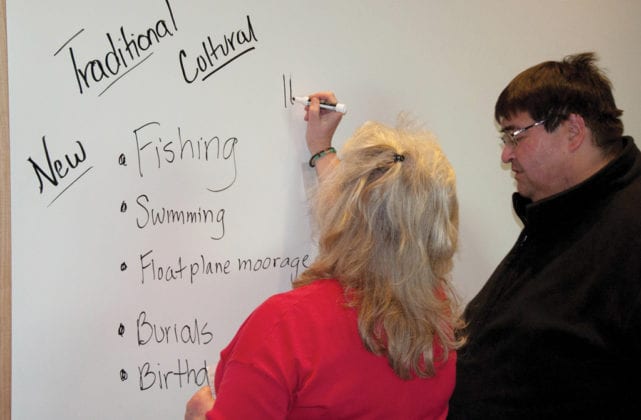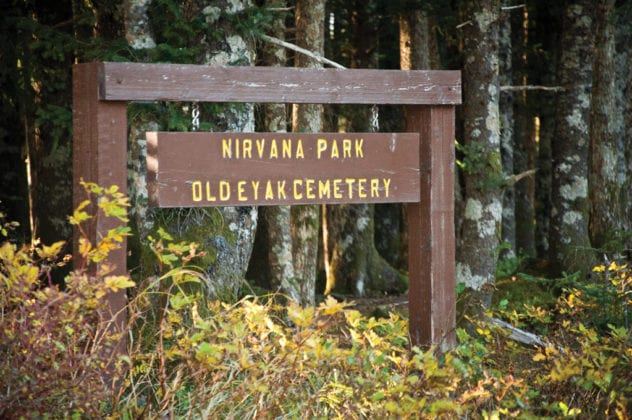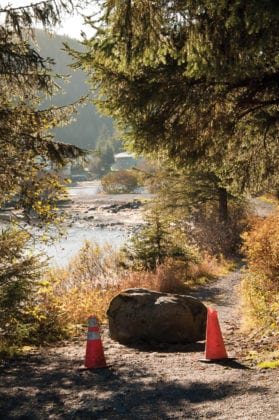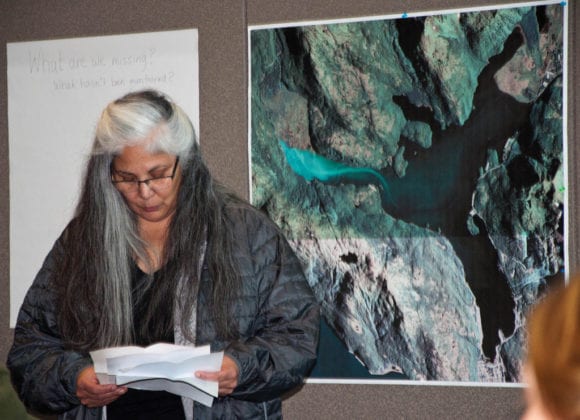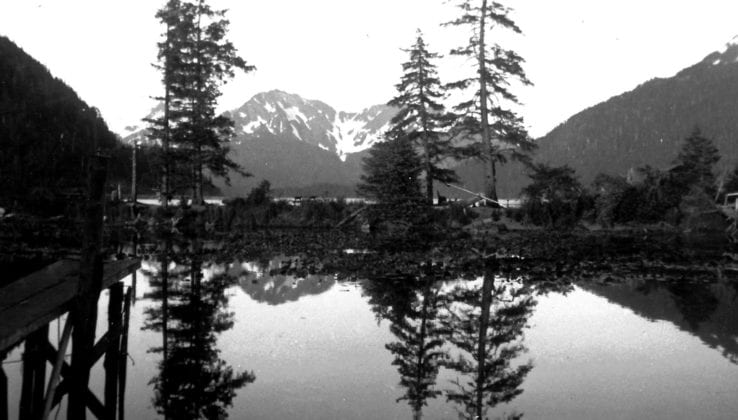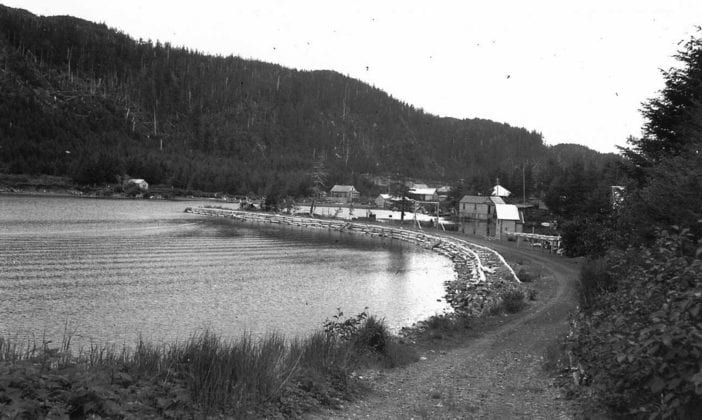It was standing room only on Oct. 12 for a public meeting over the new blockade on motor vehicle traffic to Nirvana Park and the Eyak Lake spit.
The meeting was called by city of Cordova’ public information officer and museum director Cathy Sherman, to update residents on the situation, which began which a large boulder was placed in the middle of the road two weeks ago to keep cars, trucks and four-wheelers off the spit, which juts out into Eyak Lake from the park.
The beach is often used for launching jet skis, swimming and picnicking by locals.
The Eyak Lake Burial Caucus, a formation of Eyak people acting as representatives of Eyak voices and ideas, contends that there are unmarked graves and bones of their ancestors on Nirvana Park and the spit area.
The caucus wrote a letter to the city and the Parks and Recreation Department in June, stating their concerns over the future use of this site.
A Tier 1 Rasmuson grant in the amount of $25,000 was awarded to the city on July 31, for renovations and upgrades to Nirvana Park. The deadline to use the funds is July 31, 2017. Upgrades may include signage, a designated swimming area, a portable toilet and other improvements.
Area residents have used Nirvana Park for recreational and cultural events for nearly 100 years. The grant money would allow improvements to keep the park and spit areas safe.
“The funds were requested for Nirvana Park, which is a historical park and prominent feature in Alaskan history,” Sherman said. “(It) has in recent years experienced growing use, particularly lakeside. Now jet skis are causing safety conflicts with swimmers, kayakers and float plane use. Lakeshore erosion is changing the character of the park.”
Nirvana Park and the spit area were the first graveyard and burial grounds for both the Native people and non-Native people in early Cordova.
“Over the years,” Sherman said, “Eyak Lake storms have eroded some of the ground, exposing bones from disturbed graves. Often graves were surrounded by picket fences and many, if not all, had wooden markers which have deteriorated over time as well.”
On August 2, 1993, the Smithsonian Institution repatriated the bones of an Eyak ancestor removed in the 1930s, to allow for burial. A ceremony was held at the Nirvana Park spit.
A 1909 newspaper story details the difficulty of reaching the Nirvana Park graveyard, since there was no road to the cemetery and urged citizens to be more concerned about the poor conditions.
In the 1930s, Nirvana Park was developed by local businessman Henry C. Feldman, a German immigrant who ran a hardware store on First Street.
Distinguished by its trails, interesting fences and bridges, statues and nature’s sculptures – such as massive burls, this park became a pleasant place to visit for townspeople as well as tourists, Sherman said.
“The flowers bordering paths were wild flowers Feldman had collected,” Sherman said. “There were also two houses for swimmers’ dressing rooms. When Feldman was unable to keep it up, it gradually fell in disrepair. Nature reclaimed some of it and the statues and other unique features disappeared.”
Feldman , who died in 1949, is buried in Nirvana Park.
The legal title to Nirvana Park was transferred to the city from the Bureau of Land Management in 1961.
In oral histories, Native elder Sophie Borodkin recalled Feldman visiting her father and asking permission to move some of the graves that were on the spit area so they wouldn’t be washed away.
“During the 1940s, Civilian Conservation crews helped maintain Nirvana Park and built a revetment to keep the spit from washing away. Gravel was hauled from Power Creek and spread on the paths of the park,” Sherman said.
Even today, the unique nature of the park piques the interest of locals and visitors alike. Yet, it is sacred to the Eyak People, who said they consider it should be treated as such.
That given, some Cordovans feel restricting motorized vehicle traffic to the spit poses a major inconvenience.
“I have a toddler,” Teal Hansen testified at the Oct. 12 meeting.
“Please don’t restrict access to the spit. I’d have to walk and make numerous trips down there with my child, packing food, blankets, water toys and chairs. I won’t do that. I’ll just find somewhere else to go, like out the road, because it’ll be easier,” Hansen said.
The rock in the middle of the access road to the spit discourages young mothers like herself from taking their children to the park, she said.
Pam Smith, a member of the Eyak Lake Burial Caucus, read an emotional letter on behalf of her daughter, Jen Smith, who was unable to attend, asking that the Eyak People be included on all future decisions regarding Nirvana Park.
The letter also requests a detailed plan on proposed area updates, that an Eyak representatives and an archeologist of their choosing be present, and that all motorized traffic to be spit area be halted.
In addition Smith said, the caucus wants to be in partnership with the city moving forward to begin a project with the U.S. Forest Service to use ground penetrating radar technology in further identifying unmarked Eyak graves in the Eyak Lake spit and surrounding Nirvana Park areas.
Members of the Eyak Lake Burial Caucus, now numbering more than 50 Eyaks, include Pam Smith, Jennifer Smith, William Smith and Ramona Curry.
Sherman said the city has always been aware that Nirvana Park is graveyard.
“I know the Forest Service has used this (ground penetrating radar technique extensively in their work,” Sherman said. “I’ve spoken with both the state of Alaska archaeologist and the USFS archaeologist. It is expensive. In my humble opinion, we already know these areas are burial grounds. I feel we should treat them as such.”
Sherman said that city officials would be discussing the topic further with the Native Village of Eyak and the caucus, but that no decisions have been made yet.
Sherman said she felt that the outcome reached would be satisfactory to most users.
“I was pleased at how well the meeting went,” Sherman said. “I felt everyone had an opportunity in a comfortable setting to openly express their opinions of how they would like to see the future of the park. It was great to have such a diverse group of folks and users there. I feel certain we can reach an outcome that will satisfy the majority of users, but it will involve compromise and respect by all involved.”
Sherman said she hopes the community will keep in mind that the meetings and resolution are a process.
“This will involve a lot of community conversation,” she said. “If people care, then they need to participate, attend the meetings and speak up. Attend Parks and Rec Commission meetings, attend City Council meetings and attend the Nirvana Park conversations. After walking through the park yesterday on such a beautiful fall afternoon, I was so inspired to see us do this right. There are traces of all our history there. What an incredibly special place that has touched all of us and continues to do so.”
The next Nirvana Community update meeting is set for Wednesday, Nov. 2, 4:30 to 6 p.m., prior to the regularly scheduled City Council meeting.
